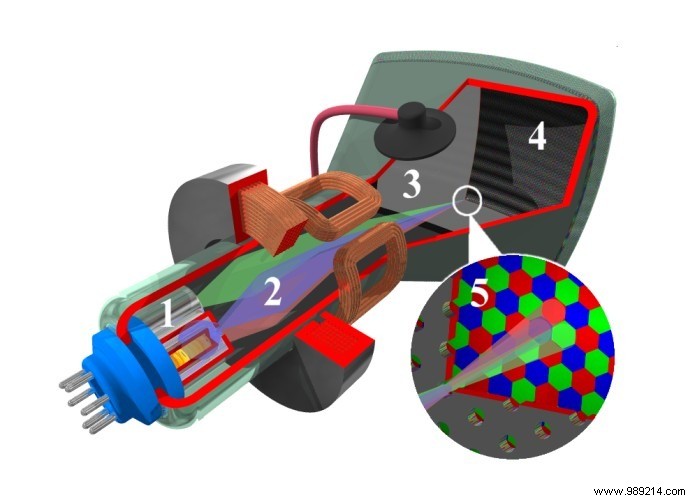If you've searched the internet for a TV buying guide, chances are you've come across videos and discussions praising CRT TV technology. It seems absurd to even speculate that outdated technology may eventually come close to modern LCDs, let alone surpass them. But that is precisely the case.
SummaryCRT displays Trounce LCDs in black detailLED backlighting is terrible for color accuracyQuantum dot technology is better but not enoughMotion is the deal breaker for LCDsA better alternative on the horizonLCD technology has some serious quality issues, and the internet has only just begun to take notice of the vocal minority of videophiles explaining how ditching bulky CRTs for modern flat-panel display technology was a trade-off. The idea being that LCDs continue to have revolutionary flaws that everyone has come to accept as a consumer electronics version of Stockholm Syndrome.
Let's take a look at the trade-offs that LCD displays entail compared to their CRT predecessors.
It's easy to get tangled up in the technical details underlying the faint black details of LCDs, but nothing beats a real-life example. Not too long ago, the Pentagon was forced to replace the LCD screens of the $400,000 Helmet Mounted Display (HMD) F-35 fighter jets with OLED panels. LCD panels relaying critical avionics and target acquisition/fire control system data directly to the pilot's helmet were plagued with an annoying green glow. The problem was so severe that the US Navy restricted night landings on aircraft carriers.

Cathode ray tubes reproduce colors by firing electrons to illuminate the red, green and blue phosphor elements applied to the glass substrate. This inherent precision allowed CRTs to achieve a level of color reproduction that was only limited by the video processing hardware prevalent at the time. LCD screen manufacturers often specify the percentage of the standard color gamut that their screens can reproduce. But covering the full color gamut was so easy for CRTs that it would have been an exercise in futility to compare them by this metric.

LED lights are inherently impure and unable to reproduce accurate white light. That's why the color-accurate LED lights used by professional photographers involve blue LEDs coated with red and green phosphors to generate pure white light. Phosphors are quite important for accurate color reproduction. The picture tube of a cathode ray tube is coated with this and is essential for rendering the displayed image. Not surprisingly, OLED screens also use phosphor-based emissive lighting to achieve excellent color reproduction.
More expensive quantum dot LCDs offer a wider color gamut and similarly improved color accuracy. These blue LEDs glow on what is essentially a sheet of plastic containing nanoparticles that glow red and green when illuminated by the blue LED backlight. However, getting a pure white backlight is great but not enough.
Even quantum dot LCDs have to reproduce colors with the same old LCD technology, which cannot faithfully reproduce colors. Worse still, the bending of light by the LCD panel and its passage through a myriad of color and bias filters makes LCD screens susceptible to parallax issues, resulting in color shift and poor viewing angles. vision.

Color reproduction suffers if you don't spend big bucks on a fancy quantum dot LCD. Additionally, the backlight of a traditional LCD isn't pure white and is marred by hues of pink, orange, and yellow. All of these factors further compound the inherent color inaccuracy of LCD screens.
If pure blacks and beautiful colors are something OLED screens are also known to achieve, then why do gamers still swear by CRT monitors? The answer lies in movement. Even the cheapest CRT monitor could easily handle an 85Hz refresh rate, with most average monitors running at 100Hz. High-end CRTs could easily hit 160Hz at screen resolutions of 1920×1200. A high refresh rate is necessary for a smoother and more enjoyable gaming experience.
CRTs, however, didn't have to compromise on image quality to achieve high refresh rates. LCD screens, on the other hand, are pretty bad at handling fast-moving content. The liquid crystals inside an LCD display are slow to reach, resulting in long pixel response times. This in turn leads to a chronic case of motion blur, which makes high refresh rate gaming a tricky business.
Higher quality LCDs with IPS panels cannot achieve faster response times without compromising color gamut and accuracy. That's why gaming monitors use TN LCD panels, which have poor viewing angles and washed out colors and poor contrast ratios. Competitive gamers cannot use LCD screens without compromising image quality.
There's still a lot to discuss, and there's a lot that CRTs understand well. For example, the raster-scanning nature of a CRT plays well with human persistence of vision and naturally eliminates motion blur. Or that CRT displays aren't limited to native resolutions and can move between them without losing image clarity or sharpness, unlike modern flat-panel displays.
At the same time, it is naïve to overlook the merits of LCD technology. Feats such as better brightness, higher resolution, ever-improving pixel density as well as sharpness and longer life. While LCD technology has clearly been a compromise, OLED has flaws that also prevent it from being a viable replacement.
However, there is hope for the future MicroLEDs which combine the best aspects of LCDs and OLEDs and do not appear to be a compromise over CRTs.
Besides the display technology, there are other things you should check when buying a gaming monitor. Check it out!